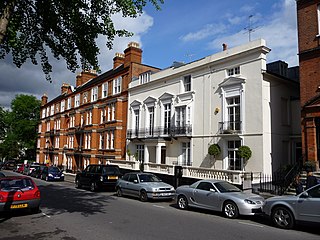
Hampstead is an area in London, England, which lies four miles northwest of Charing Cross, and extends from the A5 road to Hampstead Heath, a large, hilly expanse of parkland. The area forms the northwest part of the London Borough of Camden, a borough in Inner London which for the purposes of the London Plan is designated as part of Central London.

An apartment, flat, or unit is a self-contained housing unit that occupies part of a building, generally on a single storey. There are many names for these overall buildings. The housing tenure of apartments also varies considerably, from large-scale public housing, to owner occupancy within what is legally a condominium, to tenants renting from a private landlord.

Gospel Oak is an inner urban area of north west London in the London Borough of Camden at the very south of Hampstead Heath. The neighbourhood is positioned between Hampstead to the north-west, Dartmouth Park to the north-east, Kentish Town to the south-east, and Belsize Park to the south-west. Gospel Oak lies across the NW5 and NW3 postcodes and is served by Gospel Oak station on the London Overground. The North London Suburb, Gospel Oak, has many schools around it.

The Holly Lodge Estate is a housing estate in Highgate, north London.

Swiss Cottage is an area of Hampstead in the London Borough of Camden, England. It is centred on the junction of Avenue Road and Finchley Road and includes Swiss Cottage tube station. Swiss Cottage lies 3.25 miles (5.23 km) north-northwest of Charing Cross. The area was named after a public house in the centre of it, known as "Ye Olde Swiss Cottage".
West Hampstead is an area in the London Borough of Camden in north-west London. Mainly defined by the railway stations of the same name, it is situated between Childs Hill to the north, Frognal and Hampstead to the north-east, Swiss Cottage to the east, South Hampstead to the south-east, Kilburn to the west and south-west, and Cricklewood to the north-west. The area is mainly residential with several small shops, restaurants, cafes, bakeries concentrated on the northern section of West End Lane and around West End Green. It is served by three stations: West Hampstead on the Jubilee line, West Hampstead Overground station and West Hampstead Thameslink station. It is part of the Kilburn postal district (NW6).
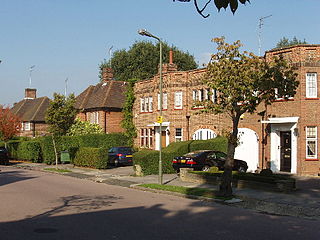
Hampstead Garden Suburb is an elevated suburb of London, north of Hampstead, west of Highgate and east of Golders Green. It is known for its intellectual, liberal, artistic, musical and literary associations. It is an example of early twentieth-century domestic architecture and town planning in the London Borough of Barnet, northwest London.

Belsize Park is an affluent residential area of Hampstead in the London Borough of Camden, England.
Commonhold is a system of property ownership in England and Wales. It involves the indefinite freehold tenure of part of a multi-occupancy building with shared ownership of and responsibility for common areas and services. It has features of the strata title and the condominium systems, which exist in Australia and the United States respectively. It was introduced by the Commonhold and Leasehold Reform Act 2002 as an alternative to leasehold, and was the first new type of legal estate to be introduced in English law since 1925.

Victoria Square is a small, rectangular garden square in Westminster, Greater London, beginning some 50 metres south of the remaining stables of the Royal Mews and 150 metres north of Victoria bus station, which stands in front of Victoria Station. It has a statue of the young Queen Victoria.
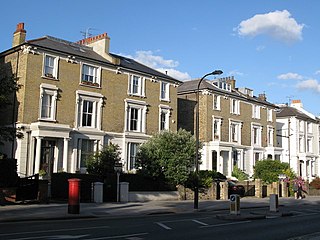
Haverstock is an area of the London Borough of Camden: specifically the east of Belsize Park, north of Chalk Farm and west of Kentish Town. It is centred on Queens Crescent and Malden Road. Gospel Oak is to the north, Camden Town to the south.
The London Borough of Camden was created in 1965 from the former area of the metropolitan boroughs of Hampstead, Holborn, and St Pancras, which had formed part of the County of London. The borough was named after Camden Town, which had gained its name from Charles Pratt, 1st Earl Camden in 1795. Since the 17th century, many famous people have lived in its various districts and neighbourhoods.

Belsize Park Gardens is a street in the Belsize Park area of Hampstead in London. Located in the London Borough of Camden, it is residential street featuring white stucco Victorian era buildings. It runs roughly southeastwards from Belsize Avenue in Belsize Village before terminating at a junction with Eton Avenue, England's Lane and Primrose Hill Road. The Grade II listed pub The Washington, dating from around 1865, is located at its eastern end.

Belsize Wood is a 0.7 hectare Local Nature Reserve and a Site of Borough Importance for Nature Conservation, Grade II, in Belsize Park in the London Borough of Camden. It is a steeply sloping site divided into a northern half, which is always open to the public and is of lesser ecological value, and a southern part which is in a better state of conservation, and which is only open at weekends. The two halves are separated by a public footpath between Lawn Road and Aspern Grove. The site is owned and managed by Camden Council.

Lissenden Gardens is a small inner urban area in north London in the London Borough of Camden at the very south east of Hampstead Heath.
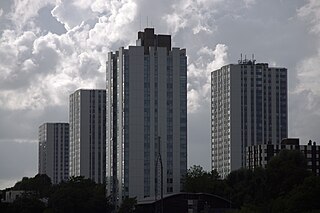
Chalcots Estate is a council housing estate on Adelaide Road and Fellows Road in Swiss Cottage in the London Borough of Camden. It was designed by Dennis Lennon and Partners. The Chalcots Estate was built on land owned by Eton College, which is reflected in the names of the individual buildings.

Hampstead Town hall is a municipal building on Haverstock Hill, Hampstead, London. It is a Grade II listed building.
Hillfield, Hill Field, or, variation, may refer to:
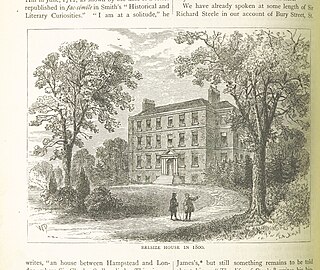
Belsize House was a historic residence in Belsize Park in what is today the London Borough of Camden. It was a country estate located south of Hampstead, which was then some distance away from the outskirts of the capital.

Belsize Avenue is a street in the Belsize Park area of Hampstead. Located in the London Borough of Camden, it runs from Haverstock Hill westwards to a junction with Belsize Terrace and Belsize Park Gardens. It is the former carriageway approach to Belsize House, a country estate that occupied the area until it was demolished in 1853 to allow residential development. A number of houses in the street were built by William Willett around 1873.
















